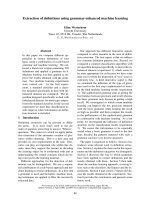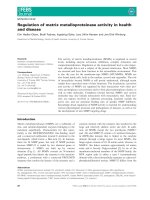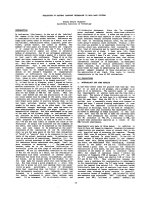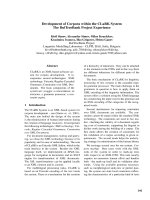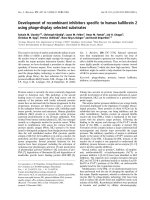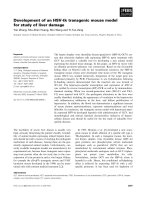báo cáo khoa học: " Development of evidence-based clinical practice guidelines (CPGs): comparing approaches" pdf
Bạn đang xem bản rút gọn của tài liệu. Xem và tải ngay bản đầy đủ của tài liệu tại đây (239.59 KB, 8 trang )
BioMed Central
Page 1 of 8
(page number not for citation purposes)
Implementation Science
Open Access
Research article
Development of evidence-based clinical practice guidelines (CPGs):
comparing approaches
Tari Turner*
1,2
, Marie Misso
3
, Claire Harris
2
and Sally Green
3
Address:
1
Centre for Clinical Effectiveness, Southern Health, Locked Bag 29, Clayton, Victoria, 3168, Australia,
2
Monash Institute of Health
Services Research, Monash University, Locked Bag 29, Clayton, Victoria, 3168, Australia and
3
Australasian Cochrane Centre, Monash Institute of
Health Services Research, Monash University, Locked Bag 29, Clayton, Victoria, 3168, Australia
Email: Tari Turner* - ; Marie Misso - ;
Claire Harris - ; Sally Green -
* Corresponding author
Abstract
Background: While the potential of clinical practice guidelines (CPGs) to support implementation
of evidence has been demonstrated, it is not currently being achieved. CPGs are both poorly
developed and ineffectively implemented. To improve clinical practice and health outcomes, both
well-developed CPGs and effective methods of CPG implementation are needed. We sought to
establish whether there is agreement on the fundamental characteristics of an evidence-based CPG
development process and to explore whether the level of guidance provided in CPG development
handbooks is sufficient for people using these handbooks to be able to apply it.
Methods: CPG development handbooks were identified through a broad search of published and
grey literature. Documents published in English produced by national or international organisations
purporting to support development of evidence-based CPGs were included. A list of 14 key
elements of a CPG development process was developed. Two authors read each handbook. For
each handbook a judgement was made as to how it addressed each element; assigned as:
'mentioned and clear guidance provided', 'mentioned but limited practical detail provided ', or 'not
mentioned'.
Results: Six CPG development handbooks were included. These were produced by the Council
of Europe, the National Health and Medical Research Council of Australia, the National Institute
for Health and Clinical Excellence in the UK, the New Zealand Guidelines Group, the Scottish
Intercollegiate Guideline Network, and the World Health Organization (WHO).
There was strong concordance between the handbooks on the key elements of an evidence-based
CPG development process. All six of the handbooks require and provide guidance on establishment
of a multidisciplinary guideline development group, involvement of consumers, identification of
clinical questions or problems, systematic searches for and appraisal of research evidence, a
process for drafting recommendations, consultation with others beyond the guideline development
group, and ongoing review and updating of the CPG.
Conclusion: The key elements of an evidence-based CPG development process are addressed
with strong concordance by existing CPG development handbooks. Further research is required
to determine why these key elements are often not addressed by CPG developers.
Published: 27 October 2008
Implementation Science 2008, 3:45 doi:10.1186/1748-5908-3-45
Received: 19 February 2008
Accepted: 27 October 2008
This article is available from: />© 2008 Turner et al; licensee BioMed Central Ltd.
This is an Open Access article distributed under the terms of the Creative Commons Attribution License ( />),
which permits unrestricted use, distribution, and reproduction in any medium, provided the original work is properly cited.
Implementation Science 2008, 3:45 />Page 2 of 8
(page number not for citation purposes)
Background
Clinicians want to give their patients the best possible
care. To do this, they need to keep up to date with the
evolving body of scientific research, and combine this sci-
entific knowledge with their own clinical experience and
each individual patient's circumstances and preferences.
This is evidence-based practice [1].
While there is a growing acceptance of the importance of
taking an evidence-based approach to clinical decision-
making, in many areas across the spectrums of speciality
and location, clinical practice is still not evidence-based
[2]. Given the enormous potential health benefits of
doing what we know works, it is essential that we find
ways of implementing evidence into practice.
One way of supporting implementation of evidence is
through evidence-based clinical practice guidelines
(CPGs) [3,4]. CPGs outline a plan of expected care, pro-
viding a guide to recommended practice and outlining the
likely outcomes of care [5]. They provide a guide to best
practice, a framework within which clinical decisions can
be made, and are used as a benchmark against which clin-
ical practice can be evaluated. Historically, CPGs were
often developed by consensus of a group of expert clini-
cians without explicit reference to research evidence. Evi-
dence-based CPG development emphasises the
importance of linking recommendations to the scientific
research that supports them, identified through a rigorous
systematic identification and appraisal of all relevant
research.
While the potential of CPGs to support implementation
of evidence has been demonstrated, it is not currently
being achieved [6]. To improve clinical practice and
health outcomes, both well-developed CPGs and effective
methods of CPG implementation are needed. Currently,
there are weaknesses to be addressed in to both these
aspects.
CPGs are increasingly being developed at local, regional,
and national levels [4,7]. The increase in publications
about the CPG field gives an indication of the rapid rise of
CPG development. In 1993, the medical subject heading
(MeSH) 'practice guideline' was added to MEDLINE, and
444 articles were classified under that heading. In the 13
subsequent years, there has been a more than eleven-fold
increase in the number of articles classified per year under
the 'practice guideline' MeSH, to a total of 4,975 articles in
2006. In comparison, over the same period of time, the
number of articles per year indexed in Medline has not
quite doubled, increasing from 413,375 in 1993 to
727,546 articles in 2006.
In parallel with the increasing interest in CPGs, several
groups responsible for producing evidence-based CPGs
have published handbooks outlining the development
methodology [8-13]. These development handbooks are
substantial bodies of work, describing in various levels of
detail the methods by which evidence-based CPGs should
be developed. These handbooks provide guidance to CPG
developers working within the authoring organisations,
and therefore influence the quality of CPGs produced by
these groups. However, in addition, the handbooks are
used much more widely by CPG developers in other
organisations, such as professional colleges, peak bodies
for clinical conditions, health services, and government
departments. As a result, the CPG development methods
proposed in these handbooks have the potential to influ-
ence the quality of hundreds, if not thousands of CPGs. At
the same time, the AGREE (Appraisal of Guidelines
Research and Evaluation) Collaboration has produced an
instrument which is widely used to assess the validity of
CPGs and which includes several criteria addressing the
rigour of development of the CPG [14].
However, in spite of the massive increase of interest in
CPGs, and the availability of CPG development hand-
books, several studies in a number of countries including
Australia, Canada, the United Kingdom, and Finland have
demonstrated that few CPGs meet quality criteria, such as
those outlined by AGREE, and that the link between
research and recommendations is an area of particular
weakness [15-24]. This mismatch between recommended
and actual CPG development processes has also recently
been highlighted in a review of use of evidence in World
Health Organisation guidelines [25]. The reasons for this
gap are unclear.
If the available handbooks provide differing guidance,
then perhaps it is reasonable that CPG developers are
unclear as to the components of a CPG development proc-
ess, and this might explain some of the weaknesses
observed in CPG development. If this is the case, it is
imperative to ascertain what the differences in guidance
are, whether these differences are gaps or contradictions in
guidance, and, importantly, why these differences occur.
On the other hand, if all the handbooks provide consist-
ent advice, then perhaps this duplication represents
wasted effort, and one handbook that synthesises the best
of each and is regularly updated, supplemented by addi-
tional materials to meet the needs of each particular
organisation, would be a better use of resources.
As part of a wider study investigating methods of evi-
dence-based CPG development in hospital settings, we
sought to compare the advice of CPG development hand-
books produced by major national or international organ-
isations that have a role in developing standards for
Implementation Science 2008, 3:45 />Page 3 of 8
(page number not for citation purposes)
evidence-based CPGs. We aimed to establish whether
there was agreement on the fundamental characteristics of
an evidence-based CPG development process. Further, we
were interested to explore whether the level of guidance
provided in these handbooks was sufficient for people
using these handbooks to be able to apply it and develop
evidence-based CPGs.
Methods
Search strategy
We identified CPG development handbooks through a
broad search of MEDLINE using search terms including
'guideline* and evidence and (method* or develop*)'.
We searched CPG websites such as the US National
Guidelines Clearinghouse
and
the Guidelines International Network http://www.g-i-
n.net, websites of known CPG development bodies, and
the internet using Google. We also asked members of the
evidence-based health care email list "evidence-based-
" to suggest potentially relevant
documents.
Inclusion criteria
We included documents published in English produced
by national or international organisations responsible for
CPG development. We only included those documents
purporting to support development of evidence-based
CPGs, not consensus-only or non-evidence-based CPGs.
We excluded documents produced by professional col-
leges or peak bodies for specific conditions, as we were
aiming to identify documents that were used widely
beyond the organisation in which they were developed.
Data extraction
We initially planned to use the AGREE instrument [14] to
compare the advice provided in the handbooks. However,
the AGREE instrument does not include criteria to address
several areas of evidence-based CPG development, such as
the appraisal of research studies and formation of an
implementation plan. To identify other key elements not
included in AGREE, we reviewed the wider guideline
development literature and drew from literature including
the Cluzeau instrument [26] from which AGREE was
derived, and other authors reporting on the components
of an evidence-based CPG development process [27,28]
to develop a more comprehensive list. On the basis of the
literature, one author (TT) developed a draft list of key ele-
ments of the CPG development process. These elements
were reviewed by two other authors (CH, SG) and consen-
sus was reached through discussion. As a result, we devel-
oped a list that included the key elements of a
development process addressed by AGREE, but which also
included additional elements.
To establish face validity, a draft list of evidence-based
CPG development elements was circulated to the evi-
dence-based health care email list, and to leaders in evi-
dence-based CPG methods for their comments. As a
result, the list was reordered and the wording of some ele-
ments was refined to reduce opportunity for misinterpre-
tation.
Fourteen key elements of the development process were
identified (Table 1). These key elements relate broadly to
four phases of CPG development: preparing for develop-
ment, systematically reviewing the evidence, writing the
CPG, and reviewing the CPG. However, they should not
be interpreted as reflecting a strictly linear process. Devel-
Table 1: Key elements of CPG development
Key Element Phase of Development
• Selecting topic Preparing for CPG development
• Determining the scope of the CPG
• Identifying and adapting existing CPGs
• Forming a multidisciplinary guideline development group
• Involving consumers
• Establishing clinical questions Systematically reviewing the evidence
• Systematic searching (including documentation of sources, filters and limits)
• Including and/or excluding identified research
• Appraising research
• Developing recommendations Drafting the CPG
• Developing an implementation strategy
• Consulting on the draft CPG
• Writing of summary versions of the CPG
• Planning for evaluating the impact, revising and updating of the CPG Reviewing the CPG
Implementation Science 2008, 3:45 />Page 4 of 8
(page number not for citation purposes)
oping an implementation strategy, for example, may
begin very early in the CPG development process. The list
of elements was neither exhaustive nor proscriptive. It was
designed to include the major elements of an evidence-
based CPG development process; it was not designed as a
checklist of what should be in a handbook, but as a frame-
work which would allow comparison of what was in each
handbook.
Two authors (TT, MM) independently read each hand-
book to identify whether it addressed each of the key ele-
ments. We were interested in whether the handbooks
mentioned each element and, if so, whether they pro-
vided enough practical information for a CPG developer
to understand not only what was required for each ele-
ment of the process but also how to complete that ele-
ment. For each key element, evidence was extracted in the
form of direct quotations for illustration where possible,
and a judgement of whether the handbook addressed
each element then assigned of either 'not mentioned',
'mentioned but limited practical detail provided', or
'mentioned and clear practical guidance provided'. Disa-
greements were resolved through discussion. During the
data extraction process, we also sought to identify any
other key elements of the CPG development process that
we had not included in our list 14 key elements. As no
human participants were involved, ethics approval was
not required.
Results
Our search did not yield any handbooks of which we were
not already aware. Six handbooks for developing CPGs
were included. The six handbooks were produced by the
Council of Europe, the National Health and Medical
Research Council of Australia (NHMRC), the National
Institute for Health and Clinical Excellence in the UK
(NICE), the New Zealand Guidelines Group (NZGG), the
Scottish Intercollegiate Guideline Network (SIGN), and
the WHO. Table 2 details the extent to which each hand-
book addressed the key elements. No additional key ele-
ments in the CPG development process were identified
during data extraction.
Five of the six handbooks provide clear guidance on the
way in which CPG topics are or should be selected. For
example the SIGN handbooks states: 'Guideline topics
are chosen on the basis of the burden of disease, the exist-
ence of variation in practice, and the potential to improve
outcome.' The NICE handbook is the only handbook
which does not address this aspect, the reason being that
for NICE 'Guideline topics are selected by the Department
of Health'.
Two of the handbooks (Council of Europe, WHO) make
no mention of defining the scope of the CPG in terms of
patient population, clinical condition, context or target
audience. SIGN provides some mention and NICE,
NZGG, and the NHMRC have very clear guidance and spe-
cific processes with the NHMRC stating: 'Before proceed-
ing, the panel should clarify the purpose of and target
audience for the guidelines. This will involve a careful
specification of the following: the conditions and clinical
problems that are at issue; the type of care providers for
whom the guidelines are intended; the type of consumers
for whom the guidelines are intended; a description of
consumers not covered by the guidelines (where it might
otherwise be assumed that the guidelines are relevant to
these consumers); the types of settings in which the guide-
lines will be employed; and the interventions to be evalu-
ated.'
Table 2: Comparison of guidance provided by CPG development handbooks
Organisation Council of Europe NHMRC NICE NZGG SIGN WHO
Topic selection ✓✓ ✓✓ Beyond scope ✓✓ ✓✓ ✓✓
Scoping the CPG - ✓✓ ✓✓ ✓✓ ✓ -
Adaptation of existing CPGs ✓✓✓✓✓✓✓-
Multidisciplinary GDG ✓✓ ✓✓ ✓✓ ✓✓ ✓✓ ✓✓
Consumer involvement ✓✓✓✓✓✓✓✓✓✓
Clinical questions ✓✓✓✓✓✓✓✓
Systematic searches ✓✓✓✓✓✓✓✓
Inclusion and exclusion - ✓✓✓✓-
Appraisal of evidence ✓ ✓ ✓✓ ✓✓ ✓✓ ✓✓
Developing recommendations ✓✓✓✓✓✓✓✓✓✓✓
Implementation plan ✓✓ ✓✓ ✓ ✓✓ Beyond scope ✓
Consultation on draft ✓ ✓✓✓✓✓✓✓✓
Writing summaries - ✓✓✓✓✓✓✓-
Evaluation, revision and updates ✓✓ ✓✓ ✓✓ ✓ ✓✓ ✓
✓✓ Mentioned and clear practical guidance provided; ✓ Mentioned, but limited practical detail;
- Not mentioned
Implementation Science 2008, 3:45 />Page 5 of 8
(page number not for citation purposes)
Adaptation of existing CPGs is addressed in all except the
WHO handbook. Varying levels of support for and details
of the process are provided. The NZGG handbook states:
'If there is already a guideline in existence that addresses
the same issue or problem, another guideline may not be
needed. An evaluation and/or adaptation of that guide-
line may be more appropriate than developing a new
guideline.' The NICE handbook differentiates between
adaptation of NICE CPGs and adaptation of CPGs devel-
oped by other organisations. For NICE CPGs, the hand-
book suggests that the evidence summaries should be
used in the form that they are found, and the wording of
recommendations adapted as necessary. The handbook
suggests that existing non-NICE CPGs can be used as evi-
dence, but new evidence summaries should be created
and new recommendations written.
The requirement for a multidisciplinary guideline devel-
opment group is mentioned by all six handbooks, with all
providing clear guidance, though the detail of the sug-
gested makeup of the group varies, as does the emphasis
on specific aspects of this process such as identification
and management of conflicts of interest.
Consumer involvement is mentioned by all six hand-
books. The degree to which consumer involvement is
required, and the nature and level of detail in the advice
on how this involvement should be facilitated vary
widely. NHMRC, NICE, NZGG, and SIGN provide clear
guidance, and WHO and The Council of Europe provide
less detailed advice. The SIGN handbooks states: 'The
involvement of patients, carers or their representatives in
guideline development is therefore important to help
ensure that guidelines reflect their needs and concerns.'
Formulation of clinical questions is only addressed in
detail in the NICE, NZGG, and SIGN handbooks, though
the other handbooks all mention the importance of defin-
ing the clinical problems to be addressed and provide lim-
ited guidance on how this should be done. While the
NICE and NZGG handbooks provide useful guidance, for
example, on how to format questions within a PICO
(patient, intervention, comparison, outcome) framework,
none of the handbooks address how to ascertain the clin-
ical questions to be addressed by the CPG.
All six handbooks mention that systematic searches
should be undertaken, and the NICE and NZGG hand-
books provide clear guidance on how to do this, with
practical details about which information sources to
search and when to use filters or limits. Some handbooks
seem to suggest that one systematic search may be enough
for an entire CPG, others are clear that a systematic search
should be undertaken for each clinical question addressed
by the CPG. For example, the Council of Europe hand-
book states: 'At present, the preferred guideline develop-
ment method is to search explicitly and systematically for
pertinent evidence to answer each central question being
addressed in the guideline.'
The NICE and SIGN handbooks provide clear guidance
on processes for inclusion or exclusion of potentially rel-
evant research evidence. The other handbooks provide
more limited information.
All six handbooks address appraisal of evidence in some
way, with NICE, NZGG and SIGN providing clear proc-
esses and templates.
Methods for drafting recommendations are at least men-
tioned by all six handbooks, with the Council of Europe
providing more limited advice than the NHMRC, NICE,
NZGG, WHO, and SIGN handbooks. NICE in particular
provides detailed advice describing how to word recom-
mendations including instructions that they should be
'standalone' and 'action-oriented'.
Similarly, all six handbooks mention the importance of
facilitating consultation on the draft CPGs, for example,
the WHO handbook states: 'Ensure peer review – Circu-
late widely to experts, professional organizations, regional
offices, countries'. NICE, NHMRC, and SIGN have clear,
well-defined consultation processes.
Writing of summaries is mentioned in all but the Council
of Europe and WHO handbooks. The NZGG asserts that
'The majority of readers and users of CPGs will not have
the time to read the whole document and it is essential
that a summary of the guideline with recommendations is
produced. Algorithms are also useful tools that can
improve guideline utilisation.'
A process for developing an implementation strategy for
inclusion in the CPG is addressed in all but the SIGN and
NICE handbooks. Implementation is beyond the scope of
the SIGN mandate, and the NICE handbook refers CPG
developers to the NICE website for implementation mate-
rials. The Council of Europe, NHMRC, and NZGG hand-
books provide particularly detailed practical guidance in
this area.
Evaluation, review, and updating of CPGs is addressed by
all of the handbooks, with the NHMRC pointedly stating:
'Evaluation of CPGs is essential. How will we know if
guidelines are worth developing, disseminating and
implementing if we do not know whether they make a dif-
ference to clinical practice and health outcomes?' The
amount of practical detail available to enable guideline
developers to carry out these processes varies between
handbooks, and often discussion is quite limited.
Implementation Science 2008, 3:45 />Page 6 of 8
(page number not for citation purposes)
Discussion
This study has a number of limitations. Resource restric-
tions meant that we were only able to search for and
include handbooks that were published in English. Our
requirement that handbooks be developed by national or
international organisations responsible for CPG develop-
ment may mean that well-developed handbooks for
guideline development were excluded, particularly in
North America where several handbooks are produced by
professional groups. Related resources such as the manual
for the U.S. Preventive Services Task Force http://
www.ahrq.gov/clinic/uspstmeth.htm were also excluded,
as they did not meet our criteria, but may be relevant to
this discussion. These restrictions were pragmatic, chosen
a priori, and allowed application of objective criteria for
inclusion, but we acknowledge that this is a limitation of
our study. Another potential limitation of this study was
the assessment of the degree to which a key element was
addressed by each of the handbooks. By its nature, this
type of assessment is subjective, and what constitutes suf-
ficient practical detail to undertaken a particular step of
the CPG development process will vary from one CPG
author to another. In almost every case, however, the
assessment of the handbooks by our two reviewers was
very similar.
This review of six 'guidelines for developing guidelines'
has highlighted a strong concordance on the central ele-
ments of an evidence-based CPG development process.
All six of the handbooks require establishment of a multi-
disciplinary guideline development group, involvement
of consumers, identification of clinical questions or prob-
lems, systematic searches for and appraisal of research evi-
dence, a process for drafting recommendations,
consultation with others beyond the guideline develop-
ment group, and ongoing review and updating of the
CPG. While the handbooks vary in the amount of detail
they provide to CPG developers in these areas, fundamen-
tally they agree that these are the key components of an
acceptable CPG development process.
It is unlikely that these handbooks were developed inde-
pendently of each other, though ironically, this is hard to
assess as few of the handbooks explicitly detail the meth-
ods by which they were developed. For example the
NHMRC, NICE, NZGG, and Council of Europe hand-
books all mention the SIGN handbook, though none
describe how it was used in their handbook development.
The degree of concordance between handbooks is inter-
esting given the range of publication dates. The hand-
books have been produced over an eight year period, with
the earliest, the NHMRC 'Guide to the development,
implementation and evaluation of CPGs' published in
1999, and the most recent, the NICE 'Guidelines Manual'
released in April 2007. Eight years is a long time in any
field, and in evidence-based practice a great deal has
changed over the past eight years. The strong similarities
between the processes recommended by these two hand-
books, and the others published in the intervening
period, may be viewed either positively, suggesting that
the process of evidence-based CPG development is well
established and widely accepted in CPG development
organisations; or negatively, suggesting that development
CPG processes are not progressing with changes in the
field of evidence-based practice.
The concordance between handbooks on what constitutes
evidence-based CPG development is particularly interest-
ing given that research shows that many CPG developers
are not following this approach [15-24]. If the advice is
consistent then the mismatch between recommended and
actual development processes may occur for a variety of
reasons. Developers may be unaware of the recom-
mended methods, handbooks may provide insufficient
information on how to complete the steps of the process,
developers may disagree with the recommended
approach or the currently recommended process may be
too complex, time-consuming, or resource-intensive to be
achievable. Confusion resulting from the difference
between the handbooks' description of the process, and
the AGREE instrument assessment of the process, dis-
cussed further below, may also contribute to the problem.
Further research could focus on identifying the barriers to
evidence-based CPG development to establish if there is a
need for more detailed advice, if the recommended meth-
ods are not feasible in some settings, or both.
While the handbooks provide information on the steps
that make up the CPG development process, they often
lack detail on how to carry out these steps in practice. A
good example is the development of clinical questions.
While all handbooks mention clinical questions and
some provide a great deal of useful information on what
constitutes a good clinical question, the PICO (patient,
intervention, comparison, outcome) framework, the
importance of ensuring clinical questions cover the whole
scope of the guideline, etc., none of the handbooks pro-
vide advice on how to actually generate the clinical ques-
tions. This lack of practical detail is found in most aspects
of the CPG development process and may explain some
the variation seen in the quality of CPGs. On the basis of
reading these handbooks, CPG developers may be aware
of what is required in an evidence-based CPG develop-
ment process but may not know how to do it. While
detailed handbooks have been produced in related areas,
such as the Cochrane Handbook of Systematic Reviews
/>, and are
sometimes referred to by CPG development handbooks,
Implementation Science 2008, 3:45 />Page 7 of 8
(page number not for citation purposes)
these have not been written with CPG developers in mind,
and may not meet their specific needs.
Given the general agreement between handbooks and the
increasing collaboration of CPG developers through
organisations such as the Guidelines International Net-
work, a question is also raised about the appropriateness
of each of the CPG development organisations continuing
to invest in updating, revising, and refining the content of
these handbooks. This surely represents a duplication of
effort. Perhaps the limited available resources might be
better spent on a collection of shared materials which
could be enriched in terms of practical detail, providing
thorough guidance on how to complete each step in the
process as well as the currently available guidance on
'what to do'. These shared materials could then be supple-
mented by smaller documents describing organisation
specific processes or requirements.
This review also highlights some differences between the
methods of evidence-based CPG development proposed
by the handbooks, and the criteria used to assess the qual-
ity of CPGs. AGREE, a widely used method of CPG
appraisal, does not include criteria addressing how the
CPG topic was selected or how the CPG will be imple-
mented. Perhaps more importantly, it also does not assess
whether systematic methods were used to appraise the
research evidence used to support CPG recommenda-
tions, which was considered a key step in a CPG develop-
ment process by the handbooks reviewed in this study.
The reason for these discrepancies is unclear, and they
seem quite odd given that each of these three areas was
addressed in the instrument from which AGREE was
developed [26]. If a consistent approach to and standard
of CPG development is to be advocated by both CPG
developers and assessors, then these discrepancies need to
be at the very least explained, and ideally, solved.
Conclusion
There has been a rapid increase in the rates of develop-
ment of CPGs. In the evidence-based CPG development
handbooks reviewed in this study, there is strong concord-
ance as to the key elements in this process: establishment
of a multidisciplinary guideline development group,
involvement of consumers, clear identification of clinical
issues, systematic searches for and appraisal of research
evidence, a process for drafting CPG recommendations
and consultation with others beyond the GDG. While it
seems that the key elements of an evidence-based CPG
development process are well established, given that they
are often not followed by developers, research is needed
to determine the barriers to implementing the recom-
mended CPG development methods; and perhaps more
practical detail or a simpler approach to developing CPGs
may be required.
Competing interests
TT, CH, SG and MM have all been involved in evidence-
based CPG development using methods adapted from the
NHMRC, SIGN and NICE handbooks. MM and SG are
staff of the Australasian Cochrane Centre, funded by the
Australian Department of Health and Ageing and sup-
ported by Monash University. Sally Green is a member of
the Cochrane Collaboration Steering Group. SG is an edi-
tor of the Cochrane Handbook of Systematic Reviews of
Interventions which informs the methodology for
Cochrane systematic reviews. The views expressed in this
paper represent those of the authors and are not necessar-
ily the views or the official policy of the Cochrane Collab-
oration (unless otherwise stated and referenced).
Authors' contributions
TT conceived of this project and developed the methodol-
ogy and data extraction approach, which TT, SG and CH
refined. TT and MM undertook the data extraction. TT pre-
pared the first draft of this article which CH, SG, MM and
TT then revised. TT is guarantor for the content of this arti-
cle.
Acknowledgements
Our thanks to the members of the EBHC email list for their useful sugges-
tions of potential documents to include in this study and comments on the
list of CPG development elements. Our thanks also to Philip Alderson and
Catherine Marshall for reviewing a draft of the manuscript, and Heather
Buchan, Dave Davis, and Valerie Palder for insightful comments on the list
of CPG development elements. We are also indebted to our reviewers and
the editors at Implementation Science for their insightful comments, and
valuable suggestions to improve the quality of this manuscript. This study
was funded through an Australian Postgraduate Award provided by the
Australian Federal Government and internal support was provided by
Monash Institute of Health Services Research.
References
1. Sackett D, Straus S, Richardson W, Rosenberg W, Haynes R: Evidence
based medicine: how to practice and teach EBM Second edition. Edin-
burgh Churchill Livingstone; 2000.
2. Santesso N, Tugwell P: Knowledge translation in developing
countries. J Contin Educ Health Prof 2006, 26:87-96.
3. Haines A, Jones R: Implementing findings of research. British
Medical Journal 1994, 308:1488-1492.
4. Woolf SH, Grol R, Hutchinson A, Eccles M, Grimshaw J: Clinical
guidelines: potential benefits, limitations, and harms of clin-
ical guidelines. British Medical Journal 1999, 318:527-530.
5. Woolf SH, George JN: Evidence-based medicine. Interpreting
studies and setting policy. Hematol Oncol Clin North Am 2000,
14:761-784.
6. Grimshaw JM, Thomas RE, MacLennan G, Fraser C, Ramsay CR, Vale
L, Whitty P, Eccles MP, Matowe L, Shirran L, et al.: Effectiveness
and efficiency of guideline dissemination and implementa-
tion strategies. Health Technol Assess 2004, 8:iii-iv. 1–72
7. Grilli R, Lomas J: Evaluating the message: the relationship
between compliance rate and the subject of a practice guide-
line. Med Care 1994, 32:202-213.
8. Council of Europe: Developing a Methodology for Drawing up
Guidelines on Best Medical Practice. Committee of Ministers of
the Council of Europe 2001.
9. NHMRC: A guide to the development, implementation and
evaluation of clinical practice guidelines. National Health and
Medical Research Council; 1999.
Publish with BioMed Central and every
scientist can read your work free of charge
"BioMed Central will be the most significant development for
disseminating the results of biomedical researc h in our lifetime."
Sir Paul Nurse, Cancer Research UK
Your research papers will be:
available free of charge to the entire biomedical community
peer reviewed and published immediately upon acceptance
cited in PubMed and archived on PubMed Central
yours — you keep the copyright
Submit your manuscript here:
/>BioMedcentral
Implementation Science 2008, 3:45 />Page 8 of 8
(page number not for citation purposes)
10. NICE: The Guideline Manual. National Institute for Health and
Clinical Excellence; 2007.
11. NZGG: Handbook for the Preparation of Explicit Evidence-
Based Clinical Practice Guidelines. New Zealand Guidelines
Group; 2001.
12. SIGN: SIGN 50: A guideline developers' handbook. Scottish
Intercollegiate Guideline Network; 2004.
13. World Health Organization: Guidelines for WHO Guidelines. In
Global Program on Evidence for Health Policy World Health Organiza-
tion; 2003.
14. Development and validation of an international appraisal
instrument for assessing the quality of clinical practice guide-
lines: the AGREE project. Qual Saf Health Care 2003, 12:18-23.
15. Littlejohns P, Cluzeau F, Bale R, Grimshaw J, Feder G, Moran S: The
quantity and quality of clinical practice guidelines for the
management of depression in primary care in the UK. Br J
Gen Pract 1999, 49:205-210.
16. Grilli R, Magrini N, Penna A, Mura G, Liberati A: Practice guide-
lines developed by specialty societies: the need for a critical
appraisal. Lancet 2000, 355:103-106.
17. Graham ID, Beardall S, Carter AO, Glennie J, Hebert PC, Tetroe JM,
McAlister FA, Visentin S, Anderson GM: What is the quality of
drug therapy clinical practice guidelines in Canada? Cmaj
2001, 165:157-163.
18. Shaneyfelt TM, Mayo-Smith MF, Rothwangl J: Are guidelines fol-
lowing guidelines? The methodological quality of clinical
practice guidelines in the peer-reviewed medical literature.
Jama 1999, 281:1900-1905.
19. Varonen H, Makela M: Practice guidelines in Finland: availabil-
ity and quality. Qual Health Care 1997, 6:75-79.
20. Ward JE, Grieco V: Why we need guidelines for guidelines: a
study of the quality of clinical practice guidelines in Australia.
Med J Aust 1996, 165:574-576.
21. Boluyt N, Lincke CR, Offringa M: Quality of evidence-based pedi-
atric guidelines. Pediatrics 2005,
115:1378-1391.
22. Cates JR, Young DN, Bowerman DS, Porter RC: An independent
AGREE evaluation of the Occupational Medicine Practice
Guidelines. Spine J 2006, 6:72-77.
23. de Haas ER, de Vijlder HC, van Reesema WS, van Everdingen JJ, Neu-
mann HA: Quality of clinical practice guidelines in dermato-
logical oncology. J Eur Acad Dermatol Venereol 2007, 21:1193-1198.
24. Harpole LH, Kelley MJ, Schreiber G, Toloza EM, Kolimaga J, McCrory
DC: Assessment of the scope and quality of clinical practice
guidelines in lung cancer. Chest 2003, 123:7S-20S.
25. Oxman A, Lavis J, Fretheim A: Use of evidence in WHO recom-
mendations. The Lancet 2007, 369:1883-1889.
26. Cluzeau FA, Littlejohns P, Grimshaw JM, Feder G, Moran SE: Devel-
opment and application of a generic methodology to assess
the quality of clinical guidelines. Int J Qual Health Care 1999,
11:21-28.
27. Woolf SH: Practice guidelines, a new reality in medicine. II.
Methods of developing guidelines. Arch Intern Med 1992,
152:946-952.
28. Vlayen J, Aertgeerts B, Hannes K, Sermeus W, Ramaekers D: A sys-
tematic review of appraisal tools for clinical practice guide-
lines: multiple similarities and one common deficit. Int J Qual
Health Care 2005, 17:235-242.

